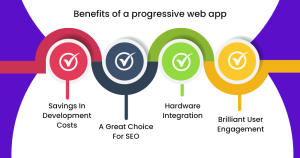 Unlocking the Potential of Progressive Web Apps (PWAs)
Unlocking the Potential of Progressive Web Apps (PWAs)
In today’s digital landscape, delivering an exceptional user experience across various devices and platforms is paramount for businesses and developers alike. Progressive Web Apps (PWAs) have emerged as a transformative solution to this challenge. This comprehensive guide delves into the world of PWAs, their foundations, key features, benefits, and how to harness their potential.
Understanding Progressive Web Apps (PWAs)
A Progressive Web App (PWA) is a web application that combines the best of both web and mobile app experiences. It’s designed to be reliable, fast, and engaging, offering a seamless user experience across different devices and screen sizes. PWAs leverage modern web technologies and principles to deliver app-like interactions directly through web browsers.
Key Features of PWAs
- Reliability: PWAs load instantly, even in uncertain network conditions. They utilize service workers, which are scripts that run in the background, to cache essential resources and ensure offline functionality.
- Performance: PWAs are optimized for speed and responsiveness. They use techniques like lazy loading and efficient resource caching to deliver fast load times and smooth interactions.
- Engagement: PWAs can be installed on a user’s home screen, just like native apps. They provide push notifications, enabling businesses to re-engage users and deliver timely updates.
- Cross-Platform Compatibility: PWAs work on various platforms and devices, from desktops and smartphones to tablets and even on emerging technologies like smart TVs.
- Security: PWAs are served over HTTPS, ensuring data integrity and user security. This makes them a secure option for handling sensitive information.
- Discoverability: PWAs are discoverable through search engines, enhancing their visibility to potential users. They can also be easily shared through URLs.
 Benefits of PWAs
Benefits of PWAs
- Enhanced User Experience: PWAs offer a seamless and consistent experience across devices, reducing user friction and increasing engagement.
- Lower Development Costs: Building a PWA is more cost-effective than developing separate apps for various platforms (iOS, Android, Windows).
- Improved Performance: PWAs are known for their fast loading times and smooth interactions, leading to higher user satisfaction.
- Offline Functionality: PWAs can work offline or in low-network conditions, ensuring users can access content and services when needed.
- Increased Conversion Rates: PWAs can be added to the home screen, making it easier for users to return to the app, which can boost conversion rates and user retention.
- Seamless Updates: Updates to PWAs are automatic, reducing the need for users to manually update apps through app stores.
Real-World Applications of PWAs
PWAs have gained popularity across various industries, offering innovative solutions to common challenges:
- E-Commerce: Retailers use PWAs to provide a fast and engaging shopping experience, with features like offline product browsing and push notifications for deals.
- Media and Publishing: News sites leverage PWAs to offer readers a responsive and offline-accessible platform for consuming news content.
- Travel and Tourism: Travel agencies and airlines use PWAs to provide travelers with real-time information, ticket booking, and travel guides, even when they are offline.
- Financial Services: Banks and financial institutions offer PWAs for secure, mobile banking with features like balance checking, fund transfers, and transaction history.
- Education: Educational platforms use PWAs to deliver course materials, quizzes, and interactive lessons that can be accessed both online and offline.
- Gaming: Casual and mobile game developers create PWAs that allow players to enjoy gaming experiences without the need for app downloads.
Building a Progressive Web App
If you’re keen to dive into PWA development, here are the essential steps to get started:
- Planning: Define your app’s purpose, target audience, and key features. Plan the user journey and consider how the app will work offline.
- Design: Create wireframes and design mockups that prioritize responsive design principles. Ensure that your app looks and feels like a native application.
- Development: Build your PWA using web technologies like HTML, CSS, and JavaScript. Implement service workers for caching and offline functionality.
- Testing: Thoroughly test your PWA across various devices, browsers, and network conditions. Ensure that it performs well, even with slow connections.
- Optimization: Optimize your PWA for performance by reducing load times and ensuring smooth interactions. Compress images and minify code.
- Security: Secure your PWA by serving it over HTTPS and protecting user data. Implement authentication and authorization mechanisms as needed.
- Promotion: Make your PWA discoverable through search engine optimization (SEO). Encourage users to add your app to their home screen for a more app-like experience.
- Monitoring: Implement analytics and monitoring tools to track user engagement, detect issues, and gather insights for further improvements.
Challenges and Considerations
While PWAs offer numerous advantages, there are some challenges and considerations to keep in mind:
- Limited iOS Support: While PWAs work on iOS devices, they may not have access to all native features and capabilities.
- Browser Compatibility: Some older web browsers may not fully support PWA features, so it’s essential to provide fallback options.
- Resource Constraints: PWAs should be designed to minimize data usage and device storage, especially for users with limited resources.
- Push Notifications: While push notifications are a significant advantage of PWAs, they should be used judiciously to avoid overwhelming users.
Conclusion
Progressive Web Apps (PWAs) have redefined the way users interact with web applications. Their ability to offer a fast, reliable, and engaging experience across different devices and platforms makes them a game-changer for businesses and developers. Whether you’re in e-commerce, media, travel, finance, education, or gaming, PWAs offer innovative solutions to improve user engagement and satisfaction.
As you embark on your PWA journey, remember that planning, design, development, and optimization are crucial steps. With the right approach and a commitment to delivering a superior user experience, you can harness the full potential of PWAs and stay ahead in the ever-evolving world of digital technology. So, start exploring the world of PWAs and elevate your web applications to the next level of user experience and functionality.

